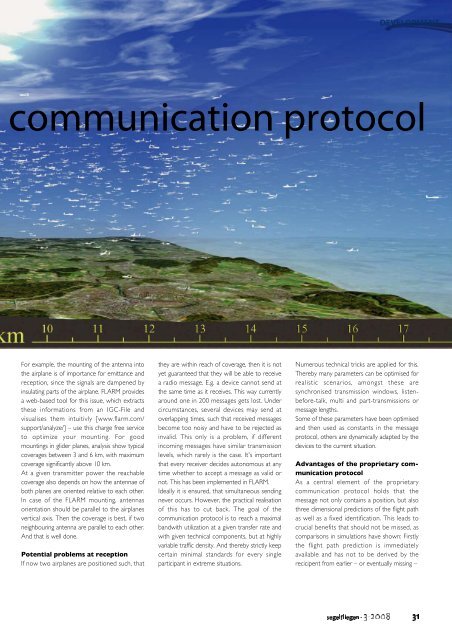Simulations for enhancing of the FLARM communication protocol
Simulations for enhancing of the FLARM communication protocol
Simulations for enhancing of the FLARM communication protocol
Create successful ePaper yourself
Turn your PDF publications into a flip-book with our unique Google optimized e-Paper software.
For example, <strong>the</strong> mounting <strong>of</strong> <strong>the</strong> antenna into<br />
<strong>the</strong> airplane is <strong>of</strong> importance <strong>for</strong> emittance and<br />
reception, since <strong>the</strong> signals are dampened by<br />
insulating parts <strong>of</strong> <strong>the</strong> airplane. <strong>FLARM</strong> provides<br />
a web-based tool <strong>for</strong> this issue, which extracts<br />
<strong>the</strong>se in<strong>for</strong>mations from an IGC-File and<br />
visualises <strong>the</strong>m intuitivly [www.flarm.com/<br />
support/analyze/] – use this charge free service<br />
to optimize your mounting. For good<br />
mountings in glider planes, analysis show typical<br />
coverages between 3 and 6 km, with maximum<br />
coverage significantly above 10 km.<br />
At a given transmitter power <strong>the</strong> reachable<br />
coverage also depends on how <strong>the</strong> antennae <strong>of</strong><br />
both planes are oriented relative to each o<strong>the</strong>r.<br />
In case <strong>of</strong> <strong>the</strong> <strong>FLARM</strong> mounting, antennas<br />
orientation should be parallel to <strong>the</strong> airplanes<br />
vertical axis. Then <strong>the</strong> coverage is best, if two<br />
neighbouring antenna are parallel to each o<strong>the</strong>r.<br />
And that is well done.<br />
Potential problems at reception<br />
If now two airplanes are positioned such, that<br />
<strong>the</strong>y are within reach <strong>of</strong> coverage, <strong>the</strong>n it is not<br />
yet guaranteed that <strong>the</strong>y will be able to receive<br />
a radio message. E.g. a device cannot send at<br />
<strong>the</strong> same time as it receives. This way currently<br />
around one in 200 messages gets lost. Under<br />
circumstances, several devices may send at<br />
overlapping times, such that received messages<br />
become too noisy and have to be rejected as<br />
invalid. This only is a problem, if different<br />
incoming messages have similar transmission<br />
levels, which rarely is <strong>the</strong> case. It's important<br />
that every receiver decides autonomous at any<br />
time whe<strong>the</strong>r to accept a message as valid or<br />
not. This has been implemented in <strong>FLARM</strong>.<br />
Ideally it is ensured, that simultaneous sending<br />
never occurs. However, <strong>the</strong> practical realisation<br />
<strong>of</strong> this has to cut back. The goal <strong>of</strong> <strong>the</strong><br />
<strong>communication</strong> <strong>protocol</strong> is to reach a maximal<br />
bandwith utilization at a given transfer rate and<br />
with given technical components, but at highly<br />
variable traffic density. And <strong>the</strong>reby strictly keep<br />
certain minimal standards <strong>for</strong> every single<br />
participant in extreme situations.<br />
DEVELOPMENT<br />
<strong>communication</strong> <strong>protocol</strong><br />
Numerous technical tricks are applied <strong>for</strong> this.<br />
Thereby many parameters can be optimised <strong>for</strong><br />
realistic scenarios, amongst <strong>the</strong>se are<br />
synchronised transmission windows, listenbe<strong>for</strong>e-talk,<br />
multi and part-transmissions or<br />
message lengths.<br />
Some <strong>of</strong> <strong>the</strong>se parameters have been optimised<br />
and <strong>the</strong>n used as constants in <strong>the</strong> message<br />
<strong>protocol</strong>, o<strong>the</strong>rs are dynamically adapted by <strong>the</strong><br />
devices to <strong>the</strong> current situation.<br />
Advantages <strong>of</strong> <strong>the</strong> proprietary <strong>communication</strong><br />
<strong>protocol</strong><br />
As a central element <strong>of</strong> <strong>the</strong> proprietary<br />
<strong>communication</strong> <strong>protocol</strong> holds that <strong>the</strong><br />
message not only contains a position, but also<br />
three dimensional predictions <strong>of</strong> <strong>the</strong> flight path<br />
as well as a fixed identification. This leads to<br />
crucial benefits that should not be missed, as<br />
comparisons in simulations have shown: Firstly<br />
<strong>the</strong> flight path prediction is immediately<br />
available and has not to be derived by <strong>the</strong><br />
recicipent from earlier – or eventually missing –


